New
Orleans Day Of The Dead
Today in New Orleans All Saints'
is more subdued but still an
important day for visiting and
decorating cemeteries. A modest
but steady stream of people
makes its way to family tombs
in Lafayette or St. Louis No.
1 or Cypress Grove, and Save
Our Cemeteries, an organization
devoted to the study and preservation
of the Crescent City's historic
graveyards, has taken to stationing
its members in several of the
older cemeteries to pass out
information and solicit memberships.
This is the traditional day
for visiting and beautifying
the cemeteries of New Orleans.
To true New Orleanians this
day is as important as Mardi
Gras.
In the aftermath of Katrina,
when all the city of New Orleans
appears to be dead, who, you
might ask, would want to hang
around this place now?
It would have to be somebody
familiar with desolation, that’s
for sure, and not put off by
challenges. Someone who brings
the party with him, so to speak;
who knows just the prescription
for these post-Katrina blues.
No it ain’t the Big Boeuf
of Fat Tuesday! It's Gede' Of
Course!
Too dread to be dead and too
much of a good time to be kept
down, now’s the time to
call on Papa Gede for a healing
wild abandon.
Known as the Lwa of the Dead
in Vodoun, Papa Gede, or Ghede,
is also known as the Baron Samdi,
and is married to Manman Brigit,
mother of all Gedes. Together
the Gedes dress in funeral colors
of purple and black and surround
themselves with graveyard imagery.
The Gedes are very wise, Papa
Gede most of all, because they
possess the accumulated wisdom
of all the dead.
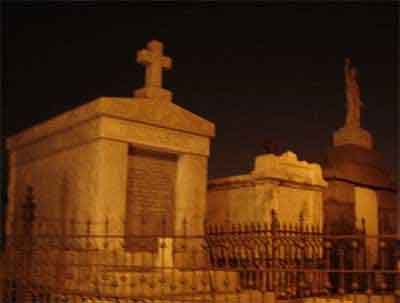
Papa Gede usually appears wearing
all black, a top hat, sunglasses
with one eye out, to symbolize
his power in the world of the
seen and the unseen. He is a
wise counselor and a shameless
trickster; he is especially
loving toward children, and
is called the patron of children
throughout the Vodoun world.
You can count on Gede to keep
you from wallowing in your sorrows,
and he usually arrives when
everyone is tired, exhausted
and ready for sleep. That’s
when Gede will want to hear
another song, have another drink,
and eat another meal!
Devotions to Gede, who is syncretized
with St. Gerard, are carried
out during the entire month
of November, but most especially
on November 1st (All Saints
Day) and 2nd (All Souls Day).
During these devotions, Papa
Gede will arrive with the entire
retinue of Gedes in tow. They
eat and drink with gluttony,
for, like Death, the Gedes are
never satisfied, and they especially
enjoy hot, peppered foods and
rum that has had Scotch Bonnet
peppers soaking in it.
But Papa Gede is not just gluttony
and cool clothes. He is the
powerful Lwa often called upon
for healing. As the Avatar of
Death it is also within his
power to effect healing, and
if ever there was a need for
healing, it is here, now.
Each Year La Source Ancienne
Ounfo & The Island of Salvation
Botanica & Magical Pharmacy
present their Annual New Orleans
DAY OF THE DEAD CELEBRATION,
Voodoo Mambo Sallie Ann Glassman
presiding holds a open to the
Public day of the dead ritual.
Followers wear white with a
purple headscarf, or black and
purple for Gede. They bring
a dish of food for the people,
and an offering for the Dead
or Gede.
Gede’s
tastes tend towards peppers,
flat breads, rum, cigars,
goats, crosses, grave-digger’s
tools, black cock feathers,
skeletons, sunglasses with
one lens, hot Creole foods,
money, the colors black,
mauve, and white. He is
syncretized with St. Gerard.
Or you can bring something
that your ancestors or loved
ones enjoyed in life.
New
Orleans Day of Holy Obligations
The beautiful city of New
Orleans is broken but not
beaten, is bent but not
destroyed. Slowly, it is
beginning to heal. She is
like a grand old dame who
is suffering from a serious,
life-threatening illness,
and she needs every healing
effort. Who better to call
on now than Papa Gede?
He is able to help with
grief, and there are many
grieving here and throughout
the Diaspora that is post-Katrina
New Orleans. Gede will also
lead the Beloved Dead across
the black waters of the
Abyss where they can rest,
and their loved ones can
heal.
|
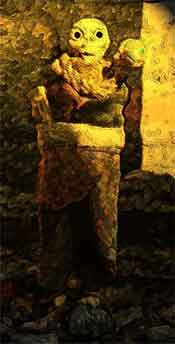 |
In
heavily Catholic New Orleans,
All Saints Day (November 1)
and All Souls' Day (November
2) have been observed for centuries
through rituals celebrating
life over death.
During the Yellow Fever epidemics
in eighteenth century New Orleans,
death always loomed close. It's
presence left the lasting impression
on this city and its inhabitants
that life is a gift, perhaps
fleeting, and should be enjoyed
to its fullest each day. And
so, on All Saints Day and All
Souls Day, New Orleanians honor
the lives of their dead loved
ones by painting tombs with
brilliant whitewashes, placing
yellow chrysanthemums and red
coxcombs on graves and ringing
statuary with immortelles (wreaths
of black glass beads). On these
days, cemeteries throughout
the city are alive with the
flickering glow from fields
of candles, as death is forgotten
and lives lived are celebrated.
The most deadly diseases to
strike Louisiana during the
antebellum period were cholera,
smallpox, malaria, and yellow
fever. In an epidemic year the
mortality rate could reach as
high as sixty percent of those
who contracted a disease. The
death rate in New Orleans ranged
from a low of 36 per 1,000 in
the late 1820s to a high of
1 in 15 during the summer of
1853. Over 12,000 people died
of yellow fever in New Orleans
that year, with still more deaths
in rural areas in south Louisiana,
marking the single highest annual
death rate of any state during
the entire nineteenth century.
Because people died faster than
graves could be dug, the popular
saying was that pretty soon
people would have to dig their
own graves.
It is one of the many rich New
Orleans' traditions we observe
annually at International House,
for we can imagine no other
city which has turned such tragedy
into such a joyous celebration
of life.
November 1st, All Saints' Day,
is the time when folks in New
Orleans traditionally come to
pay their respects and leave
flowers on the family plot.
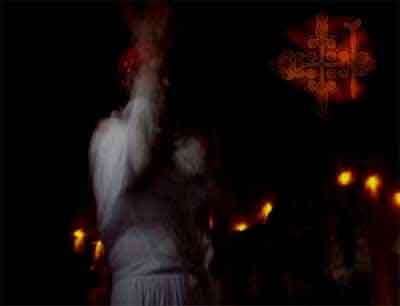
Of these older cemeteries, St.
Roch's, probably the best kept
up, most retains the older air
of All Saints' hustle and bustle.
Once at the heart of the Ninth
Ward's life, it is still visited
by many former residents of
the neighborhood who have moved
to Gretna or St. Bernard Parish
or other suburbs. Practically
every grave and every niche
in the wall "ovens"
have flowers. People greet each
other, chat with each other,
or stop to joke with St. Roch's
indefatigable sexton, Albert
Hattier, about his own recently
completed tomb, which sits prominently
guarding the gate to St. Roch's
No. 2.. Lower Louisiana is famous
for its "Cities of the
Dead," the cemeteries of
above-ground tombs and wall
crypts, or "ovens."
Because so much of the area
is below sea level, coffins
did not readily stay in the
ground but rather floated to
the top. It only took a heavy
rain to raise the dead. To address
the problem antebellum authorities
at times prohibited interment
in the ground. Thus, most south
Louisianians were, and still
are, buried above the earth's
surface.
Burial construction varied by
class and faith. Wealthy Louisianians
commissioned large, elaborate
family tombs, while those with
lesser means were buried in
small units of ovenlike wall
crypts. The very poor who could
not afford tombs or crypts were
buried below ground, often in
unmarked or mass graves. During
epidemics the dead were often
buried one on top of another.
Jews also interred their dead
below ground. According to Jewish
belief, the body had to return
to the soil and thus was usually
buried in the ground in a wooden
casket without nails.
But it is
only in a few of Louisiana's
rural communities, like Lacombe
on the north shore of Lake Pontchartrain,
and Lafitte, on Bayou Barataria,
where the sublime night-time
vigils, once more common, still
take place to give All Saints'
an especially distinctive aspect.
In both of these places, as
well as in many others in South
Louisiana where All Saints'
is observed without the candlelight
vigil, the week before is a
time of intense preparation.
Undergrowth, weeds, and any
cemetery trash are cleaned up,
and tombs and graves, most of
which have copings or slabs
or in some other way conform
to the South Louisiana style
of raised grave structures,
are painted (once with whitewash,
today more likely with latex)
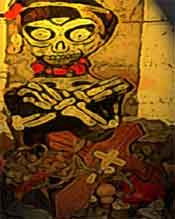 |
Antebellum
Louisianians mourned the
dead by staging elaborate
funerals and processions,
decorating graves at the
time of death and on All
Saints' Day and All Souls'
Day, placing black wreaths
on doors and black ribbons
on door pulls, and wearing
clothes and jewelry that
symbolized stages of mourning.
Many customs incorporated
Latin and African elements,
a cultural heritage from
Louisiana's colonial era.
New Orleans Mourning jewelry
is composed in part of human
hair. Hair jewelry could
be made by the mourner or
by artists who specialized
in such work with hair clipped
from the deceased at the
time of death. |
The level
of subterranean water is high
enough that coffins tend to
pop up out of the ground. An
exception is Holt cemetery,
where the graves are in the
ground.
"It's a cemetery for mostly
people who don't have the money
to build those big magnificent
tombs. So there are a lot of
handmade, homemade tombs, made
with found objects, with materials
that are just lying around,
very impermanent materials.
It's a lot of very improvised
memorials. Very personalized
as well."
Rob Florence is the author of
New Orleans Cemeteries: Life
in the Cities of the Dead.
"It's one of the things
that's very moving about this
cemetery. You can tell that
people have put a lot of thought
and a lot of time and a lot
of devotion into these memorials
and within a year or even six
months, it's not gonna be there."
The New Orleans Saints are a
professional American football
team based in New ... since
the franchise had been granted
to New Orleans on All Saints'
Day. African-American influences
on Louisiana mourning traditions
included the celebration of
funerals with dancing, music,
and singing.
The wearing of white at funerals
and other celebrations involving
the dead had religious symbolism
and was most likely an African-American
cultural carryover. In 1819
English-born architect Benjamin
Henry Latrobe encountered a
funeral procession in New Orleans
for an old Congo slave woman
and wrote:
In going home to my lodgings
this evening about sunset, I
encountered a crowd of at least
200 negroes, men and women,
who were following a corpse
to the cemetery. Of the women,
one half at least carried candles,
& as the evening began to
be dark, the effect was very
striking, for all the women
& many of the men were dressed
in pure white. The funerals
are so numerous here, or rather
occupy so much of every afternoon
in consequence of their being,
almost all of them, performed
by the same set of priests,
proceeding from the same parish
Church St. Louis Cathedral],
that they excite hardly any
attention.
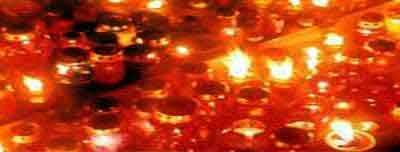
In antebellum
Louisiana, and even now, celebration
of death did not end with the
funeral. On or near tombs and
crypts friends and relatives
placed immortelles, wreaths
commonly made of such durable
materials as glass and wire.
According to older Latin Catholic
tradition, the living also remembered
the dead on All Souls' Day (2
November), burial sites, adorned
them with flowers and ornaments,
and held midnight feasts. Louisianians
continue to observe All Saints'
and All Souls' Day in much the
same way today.
NEW
ORLEANS STYLE DAY OF THE
DEAD
DIA
DE LOS MUERTOS WITH SALLIE
ANN GLASSMAN
La
Source Ancienne Ounfo &
The Island of Salvation
Botanica & Magical Pharmacy
Thursday,
November 1st
3319 Rosalie Alley
New Orleans, LA.
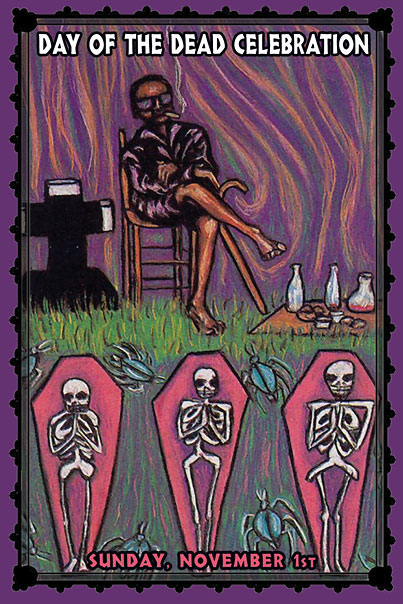
Followed
by potluck supper
& procession to
the cemetary to feed
the dead. Please wear
white with a purple
headscarf, or black
and purple for Gede.
Bring a dish (not
a blonde) for the
people and an offering
for the DEAD or GEDE.
Gede's tastes tend
towards peppers, flat
bread, rum, cigars,
goats, crosses, gravedigger's
tools, black cock
feathers, skeletons,
sunglasses with one
lens, spicy creole
foods, and money!
He is syncretized
with St. Gerard. Or
you can bring something
your ancestors or
loved ones enjoyed
in life.
FOR
MORE INFO AND RSVP:
(504)948-9961 |
READ
AND LEARN MORE ABOUT LAST
YEARS DAY OF THE DEAD RITUAL!
CHECK
AVAILABILITY FOR HOTELS IN
NEW ORLEANS

|